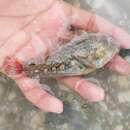Diagnostic Description
provided by Fishbase
Gill opening extending ventrally to opposite 5th-11th pectoral-fin ray; segmented dorsal-fin rays 13-15; segmented pelvic-fin rays 3; last dorsal-fin spine 8.5-15.5% SL; dorsal-fin spines robust and stiff; no elongate fleshy flap present posteriorly on lower lip; infraorbital bones 5; upper lip with free dorsal margin extending around snout; fleshy lobes of lower lip almost semicircular in lateral view and separated anterioventrally by a broad shield-shaped lobe; bony interorbital width comparatively narrower; dark spot usually absent in spinous dorsal fin, but if present centered on third spine; mandibular pores 3.
Life Cycle
provided by Fishbase
Oviparous, distinct pairing (Ref. 205).
Morphology
provided by Fishbase
Dorsal spines (total): 11 - 13; Dorsal soft rays (total): 13 - 15; Anal spines: 2; Analsoft rays: 14 - 17
Biology
provided by Fishbase
Herbivorous, with short chisel-like teeth used to scrape algae and detritus from surfaces (Ref. 94105). Oviparous. Eggs are demersal and adhesive (Ref. 205), and are attached to the substrate via a filamentous, adhesive pad or pedestal (Ref. 94114). Larvae are planktonic, often found in shallow, coastal waters (Ref. 94114).
Importance
provided by Fishbase
fisheries: of no interest

